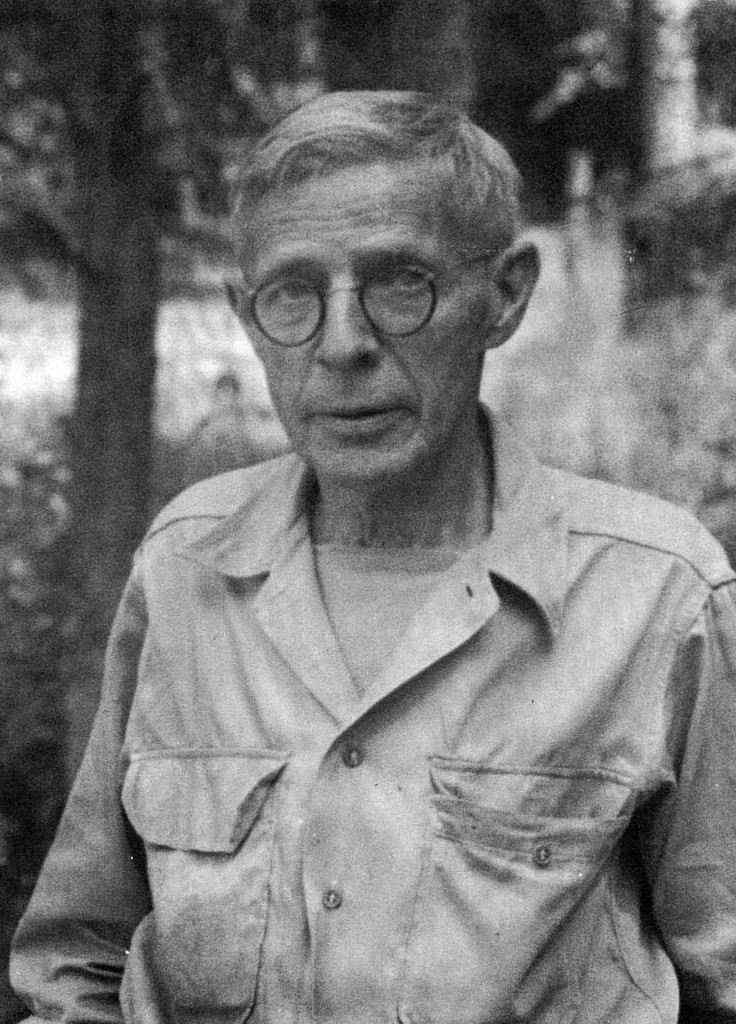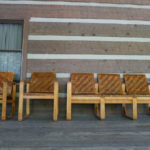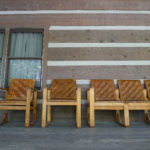Pine Mountain Settlement School
Series 09: BIOGRAPHY
Frank W. Cheney (1881-1958)
Woodworking Teacher, 1947-1949
Traveler
FRANK W. CHENEY Staff
Teacher, Woodworking 1947-1949
TAGS: Frank Cheney, woodwork, Mt. Nebo Silk Company, silk manufacturing, industrial training, woodcraft, Jamestown NY, Cornell University, Manilla Trade School, International College, Smyrna Turkey, Shanghai, China, WWII, Musssoorie India, Woodstock School, H.R.S. Benjamin, stonemasonry, journalism, Pittman School, Pi Beta Phi School, Gatlinburg Tennessee, Dayton High School
Frank W. ‘Unk’ Cheney was born in 1881 and died in 1958. What he managed to pack into his lifetime of 77 years, leaves one almost incredulous. Pine Mountain was fortunate to share only a small fraction of his life, yet his two years at the School left a rich legacy. Much of that legacy is contained in his woodwork and for a few brief years Pine Mountain had one of the finest woodworkers in the State of Kentucky on their staff. Cheney was an instructor of woodworking at Pine Mountain from 1947 until 1949.
Frank W. Cheney: MT. NEBO SILK COMPANY, MANCHESTER, CONNECTICUT
Cheney was a descendant of the Cheney family that had a prosperous business in silk manufacturing in Connecticut. His relative, Frank W. Cheney, was one of the founders of the Cheney Brothers and Mt. Nebo Silk Company in Manchester, Connecticut, in 1838. The Cheney silk industry was one of the country’s most important manufacturing initiatives and one that led the country into the transition from farming to industrialization. At the height of the milling industry’s operation in 1916, the company covered some 36 acres of floor space. *[See Cheney Brothers’ Silk Mills, accessed 2015-03-28.]
The international travel of the founders and the introduction of new production methods of the textile mills introduced by the Cheneys was important to the industrial revolution transition following the War Between the States. Named for his relative, Frank, and his father, Frank W. Cheney, ‘Unk’ also shaped his life with a broad brush. He became a world traveler, but unlike his legacy, he focused on the social and educational side of the industrial revolution — the industrial arts as a change agent — and not on the industrial economic race to the top. He was a world traveler, a life-long teacher, a consummate woodworker, a poet, a writer, and a friend to all who knew him.
Frank W. Cheney: JAMESTOWN, NY, AND CORNELL UNIVERSITY
His teaching career began very early in his life. He was just preparing to graduate from high school in Jamestown, New York, the town of his birth, when the teacher of manual arts, became ill. Cheney had shown exemplary skill in the class and the principal asked Cheney if he would replace the ill teacher. The year was 1903. While continuing his employment at his high school in Jamestown, he picked up classes at Cornell University where he majored in industrial arts. He graduated from Cornell and then taught industrial arts in Bradford, Pennsylvania, until 1908 when he traveled across the country, finally landing in California in a brief teaching position in late 1908.
CALIFORNIA AND THE PHILIPPINES
From California, he traveled on to the Philippines where he took a position as an instructor of industrial arts at the Manila Trade School from 1908 to 1916. He then served as the superintendent of education at the School from 1916 until 1920. While there he wrote a manual for industrial arts that is still widely circulated in some schools in the Philippines. He was known throughout the islands for his consultations on the industrial arts in the schools. While in Manilla he also, for a time, was the sports editor for the Manila Bulletin. His years in the Philippines were keenly observed and recorded in a small volume of comments, poetry, and satire about his years in the country. While he continued to instruct at the School until 1923, he apparently left the Trade School that year but remained in the Philippines.
TURKEY
In 1929 he left the Philippines and traveled on to Turkey where he took a two-year position teaching at the International College in the city of Smyrna, Turkey. Smyrna was still recovering from a catastrophic fire that had virtually destroyed the city and some 10,000 to 100,000 Armenians and Greeks and Turks. The origins of the fire are disputed, but it was most likely related to the unrest following the Armenian Turkish conflict in the 1920s. Following his brief international travel, he returned to California in 1931 and again taught industrial arts for three more years.
SHANGHAI, CHINA, AND WWII PRISONER
In 1932 his rambling again took him out of the country, this time to Shanghai, China, where he taught, studied the culture of the Far East and continued his interest in poetry. By 1934 Shanghai was one of the largest cities in the world and one of the most progressive. Work on the Greater Shanghai Plan was moving along and the people and city were moving toward a new and progressive urban center. It was a city that was modeled on the contemporary design set forth in Ebenezer Howard’s 1902 book, Garden Cities of Tomorrow. ‘Unk’ had always had a deep interest in contemporary art and surrounded himself with the works of noted contemporary artists, poets and writers. Shanghai was a city that was, like Frank Cheney, full of energy.
In January of 1932, all the dreams of Shanghai and ‘Unk’ were shattered by the bombing of the city by the Japanese. Over the course of the next few years, Europeans and some 400,000 Chinese retreated to the exterritoriality of the area known as the “Solitary Island,” which was an island of prosperity, surrounded by the Sino-Japanese war. In this foreign concession area, Europeans with no visas were protected, as were Jews and other non-Chinese for a time. But, on December 7, 1941, Pearl Harbor was attacked by the Japanese and all concessions in Shanghai were removed for occupants of the Solitary Island, except for the French. America was at war and ‘Unk,’ along with many others, was taken prisoner and removed to a Japanese prison camp at Chapel. There he remained for the length of the war.
Typical of Cheney, in the camp he again became the teacher. He organized a library for the prisoners and started a school for both adults and children. He later spoke of that experience and said, “Seldom was there any gathering of such educated persons as we had in that one camp, and the school we had was an incentive to all our students to complete the day and live even if it was just to attend class.” It was at Chapel that he encountered James, a talented young boy whom he adopted and eventually brought back to the United States at the end of the war, but not before he had made a side trip in 1946 with his adopted son to Woodstock School in Mussoorie, India, where he took a one-year teaching position in 1946.
Frank W. Cheney: WOODSTOCK SCHOOL in MUSSOORIE, INDIA
Located in the protected foothills of northern India in the State of Uttarakhand, near Mussoorie, the Woodstock School resembles in many ways Pine Mountain Settlement School. It was the first Asian school to attain U.S. accreditation. The area, some 250 acres of forested slopes looks out toward the snow-capped peaks of Tibet. Today it offers a world-class education and the “Center for Imagination” located at the School carries many of the values and focus on creativity that attracted Frank Cheney.
Frank W. Cheney: PINE MOUNTAIN SETTLEMENT SCHOOL
In 1947 ‘Unk’ returned to the United States where he legally adopted James and enrolled him first in Pine Mountain Settlement School for one year (1947-1948), then in Berea (KY) College. The Berea years were good for James Cheney who later became a federal bank examiner. It was through Berea that Frank W. Cheney came to Pine Mountain Settlement School. However, the initial contact came on October 16, 1946, in a letter from F.W. Cheney to H.R.S. Benjamin who was director of Pine Mountain.
An excerpt from a letter written in September 1947 by Dorothy Nace, a PMSS secretary, to a former teacher, Alice Joy Keith, provides a glimpse of Frank Cheney’s activities at the School:
We are now in our 4th week with almost more new students than old, but a fairly smoothly running school…..Mr. Cheney, who taught the Benjamin boy woodworking in the Shangh[a]i American School is ably directing the shop work and major repairs which have turned the plant room and terrace into additional lab space for the science room. He has added a large living room to the little cabin above the shop building and is very comfortable in it. The tiny back room is a bath.
Though ‘Unk’s’ two years at Pine Mountain were brief, as were many of his teaching appointments, they were important years to Frank Cheney and he remained in Kentucky for the last years of his life.
Like other staff who worked at Pine Mountain, Frank Cheney kept in contact with his colleagues at the School for many years following his departure. Importantly, he left his mark on the aesthetics of the School in a series of chairs that speak of his interest in contemporary art, but also his recognition of the local chair craft. The materials in his contemporary chairs contain native maple and hickory caning, materials common to the Pine Mountain Valley. The angular ‘Unk’ Cheney Chairs may be found throughout the buildings on campus, most often in the West Wind living room, Laurel House, and Hill House (Infirmary].
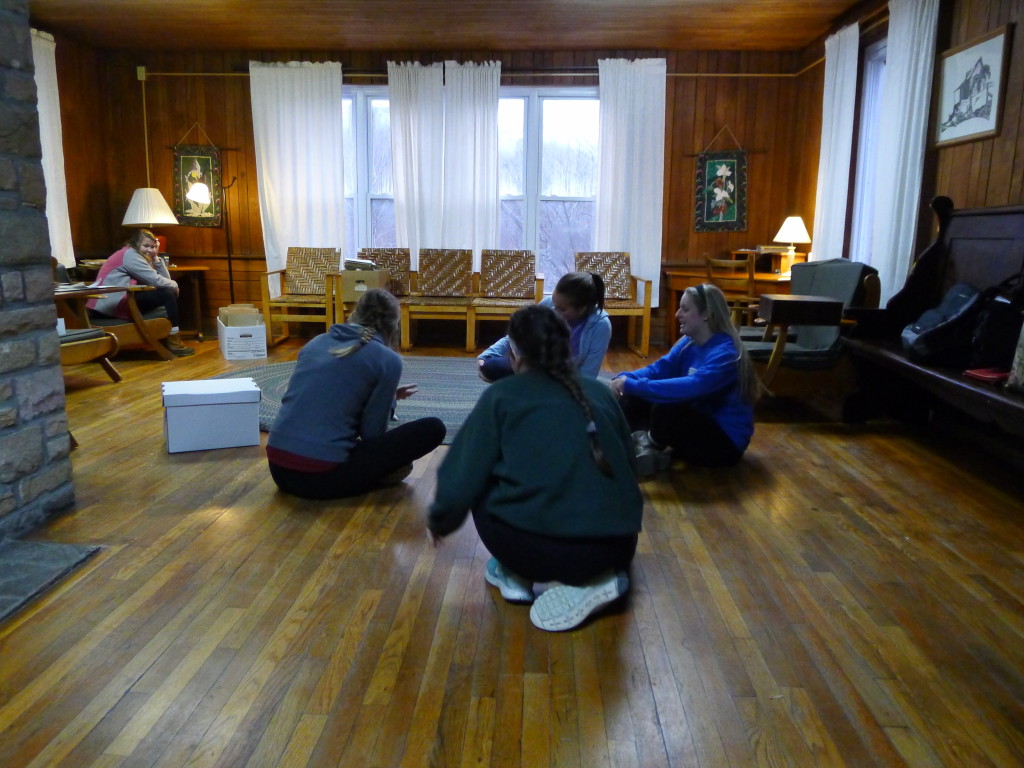
West Wind living room with ‘Unk’ Cheney chairs under window. (Foreground) AET sorority girls working on archives for the School. [P1060781.jpg]
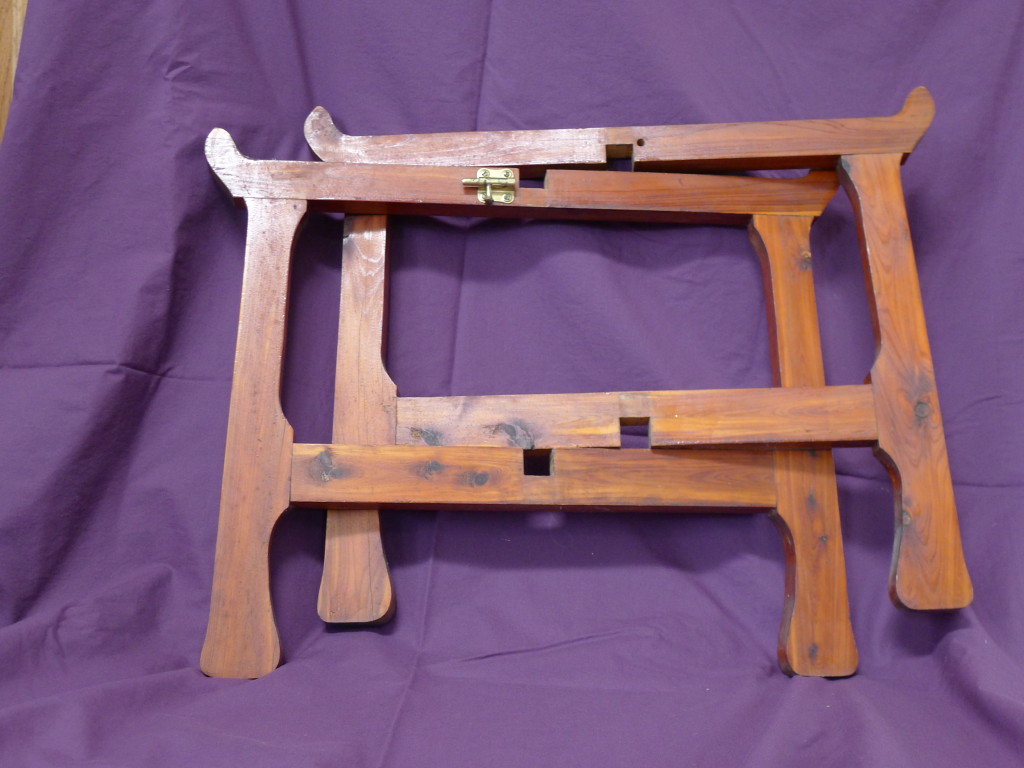
Rustic cherry stand for a folding table designed by Frank W. ‘Unk’ Cheney. The stand was built to carry a turned circular top. (In private collection.) [P1070097.jpg]
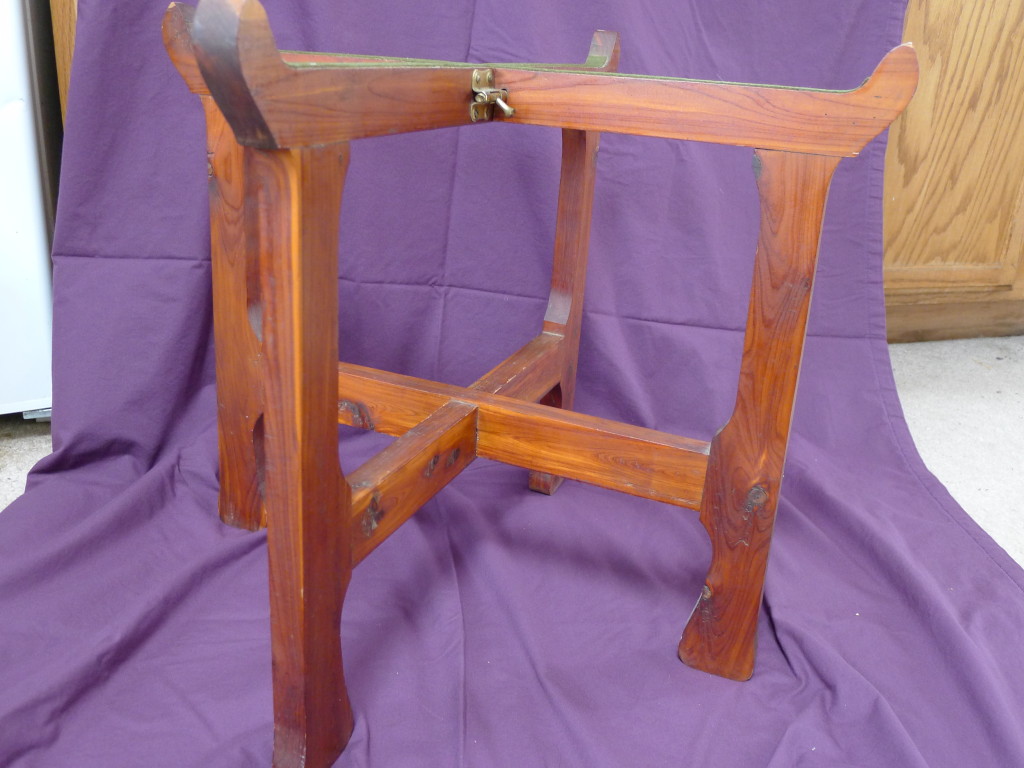
Rustic cherry stand for a folding table designed by Frank W. Cheney. (In private collection.) [P1070102.jpg]
PITTMAN SCHOOL AND THE GATLINBURG PI BETA PHI SCHOOL
When Frank Cheney left Pine Mountain in 1949 he went to Sevierville, Tennessee, to the Pittman Community Center where he taught industrial arts for two years. Similar to Pine Mountain, the Pittman Center or PIttman School was a self-sustaining settlement modeled institution on the Middle Fork of the Little Pigeon River. Cheney came to Pittman during a time of transition for the school that eventually led to the combining of the Gatlinburg Pi Beta Phi High School and the Pittman Center by the Sevier County Board of Education.
DAYTON HIGH SCHOOL, KENTUCKY
Following Cheney’s departure from the Pittman School in 1951, he returned to Kentucky where he secured a position with Dayton (KY) High School, located in Northern Kentucky across the river from Cincinnati, Ohio. He was still teaching at the Dayton High School at the time of his death from a fatal illness in May 1958 at the age of 77.
In his front-page obituary in the Cincinnati Enquirer, Tuesday, May 13, 1958, reporter Tom Brennan, noted that Cheney “was still teaching students the art of using tools and the knack and need of being a man,” at the time of his death. Brennan also noted in his extensive obituary that “the adventurous Cheney made 14 trips across the Pacific Ocean and went around the world twice. He obtained a pilot’s license and later became captain of an ocean liner,” and that he accepted “such jobs as fire warden, chef, stonemason, and journalist.” ‘Unk’ Cheney was never short on talent nor was he ever reluctant to engage the spirit of adventure.
A small volume containing gathered poetry and writings is in the University of Michigan, Bentley Library. Also included are newspaper clippings and autobiographical narratives.
Restless, energetic, talented, sensitive, and very caring, Frank Cheney never married but shared his life with a broad range of people across the world. Looking back on his life it is not hard to imagine that he had no time to “settle in.” While the exact dates for some of his adventures are not known, it is clear that to him there were too many places not visited, and too many people not met and taught. Though his early years suggest an unsettled life, his last years were more rooted and focused on his woodworking craft. He never veered in his life-time from sharing his knowledge of industrial arts and continuing to help young boys who needed discipline and structure in their lives. Serving as an uncle, ‘Unk,’ is said to have adopted 13 children. Of those adoptees, 7 now live abroad. He obviously inoculated them with the same spirit of adventure that was his life story.
- Classic “Unk” Cheney Chairs. [P1110139_small]
- Classic “Unk” Cheney Chairs. [P1110141_small]
**********
The U.S. Census of 1900 lists Frank W. Cheney, born 1881, as the son of Frank W. Cheney (a policeman) and Delia A. Cheney. He had two siblings, Rollin K. (b. 1880) and Lulu E. (b. 1884). All family members were born in New York, and at that time, the family was living in Jamestown, New York. He died in 1958 and was buried alongside his parents at the Lake View Cemetery in Jamestown, New York.
See Also:
ARTS AND CRAFTS – Overview
ARTS AND CRAFTS Guide
ARTS and CRAFTS Woodworking
FRANK W. CHENEY Correspondence
|
Title |
Frank W. Cheney |
|
Alt. Title |
‘Unk’ Cheney ; Frank W. Cheney Jr. |
|
Identifier |
|
|
Creator |
Pine Mountain Settlement School, Pine Mountain, KY |
|
Alt. Creator |
Ann Angel Eberhardt ; Helen Hayes Wykle ; |
|
Subject Keyword |
Frank W. Cheney ; ‘Unk’ Cheney ; Pine Mountain Settlement School ; education ; teachers ; industrial arts ; tutors ; students ; community education ; high schools; Burton Rogers ; Intervention ; Archives ; Notes from the Pine Mountain Settlement School ; Pine Mountain, KY ; Harlan County, KY ; Philipines ; Shanghai ; Turkey ; Pi Beta Phi, Gatlinburg, TN ; Pittman School, TN ; Pittman Community Center, TN ; Sevier County Board of Education ; fire wardens ; chefs ; stone masons ; journalists ; poets ; writers ; chairs ; tables ; woodworking ; wood-turning ; Jamestown, NY ; |
|
Subject LCSH |
Cheney, Frank W. , — 1881 – May 1958. |
|
Date |
2015-04-09 |
|
Publisher |
Pine Mountain Settlement School, Pine Mountain, KY |
|
Contributor |
n/a |
|
Type |
Text ; image ; |
|
Format |
Original and copies of documents, correspondence and photographs in file folders in filing cabinet |
|
Source |
Original and copies of documents and correspondence in file cabinet ; Series 09: Staff/Personnel ; |
|
Language |
English |
|
Relation |
Is related to: Pine Mountain Settlement School Collections, Series 09: Staff/Personnel ; |
|
Coverage Temporal |
1881– 1958 |
|
Coverage Spatial |
Pine Mountain, KY ; Harlan County, KY ; Shanghai, China ; Manila, PI ; Smyrna, Turkey ; Woodstock, Mussoorie, India ; Jamestown, NY ; Bradford, PA ; Cincinnati, OH ; Gatlinburg, TN ; Sevierville, TN ; Newport, TN ; Dayton, KY ; Oakland, CA ; |
|
Rights |
Any display, publication, or public use must credit Pine Mountain Settlement School, Pine Mountain, KY. Copyright retained by the creators of certain items in the collection, or their descendants, as stipulated by United States copyright law. |
|
Donor |
n/a |
|
Description |
Core documents, correspondence, writing, and administrative papers created by or addressed to Frank W. Cheney ; clippings, photographs, publications by or about Frank W. Cheney ; |
|
Acquisition |
n/d |
|
Citation |
“[Identification of Item],” [Collection Name] [Series Number, if applicable]. Pine Mountain Settlement School Institutional Papers. Pine Mountain Settlement School, Pine Mountain, KY. |
|
Processed By |
Special Collections Staff 2001; Helen Hayes Wykle ; Ann Angel Eberhardt ; |
|
Last Updated |
2015-04-09 hhw ; 2015-08-28 hhw ; 2015-09-28 aae ; 2025-07-11 aae ; |
|
Bibliography |
Sources “Find A Grave Index,” database, FamilySearch (https://familysearch.org/ark:/61903/1:1:QV2M-F5ZS : accessed 28 September 2015), Frank W. Cheney Jr, 1958; Burial, Jamestown, Chautauqua, New York, United States of America, Lake View Cemetery; citing record ID 53993592, Find a Grave, http://www.findagrave.com. “Frank W. Cheney.” Private letters and newspaper clippings (Hayes files) ; Alice Joy Keith Correspondence (054) ; Boarding School Students ; Guide to PMSS Workers ; Box 24 Director’s Office Files (24-39). Series 09: Staff/Personnel. Pine Mountain Settlement School Institutional Papers, Pine Mountain Settlement School, Pine Mountain, KY. Archival material. “United States Census, 1900,” database with images, FamilySearch (https://familysearch.org/ark:/61903/1:1:MS6N-RGS : accessed 28 September 2015), Frank W Cheney in household of Frank W Cheney, Jamestown city Ward 1, Chautauqua, New York, United States; citing sheet 5B, family 93, NARA microfilm publication T623 (Washington, D.C.: National Archives and Records Administration, n.d.); FHL microfilm 1,241,014. Internet resource. Bibliography Cheney, Frank W.. Woodworking for Beginners, 1915. A text-book developed by Frank Cheney to be used in teaching his classes in industrial arts courses in schools and shops in the Philippines. Available in a reprint ISBN 9785518651920 Cheney, Frank W. Frank W. Cheney Poems. University of Michigan – Bentley Historical Library, 1 v. 1946. Copies of poetry, largely light verse, recounting experiences in the Philippines; and newspaper clippings containing biographical material. Archival material. “Cheney Brothers’ Silk Mills.” from The Story of Silk and Cheney Silk, 1916. Textile Industry History. [accessed 2015-03-28.] Horton, George, The Blight of Asia, An Account of the Systematic Extermination of Christian Populations by Mohammedans and of the Culpability of Certain Great Powers; with the True Story of the Burning of Smyrna. Indianapolis: The Bobbs-Merrill Company, 1926; repr. Sterndale Classics and Taderon Press, London, 2003 ISBN 978-1-903656-15-0. Records of the International College (Smyrna, Turkey).1914-1931, n.d. (inclusive). Yale University Library Repository. Archival material. |
Return To:
BIOGRAPHY – A-Z

